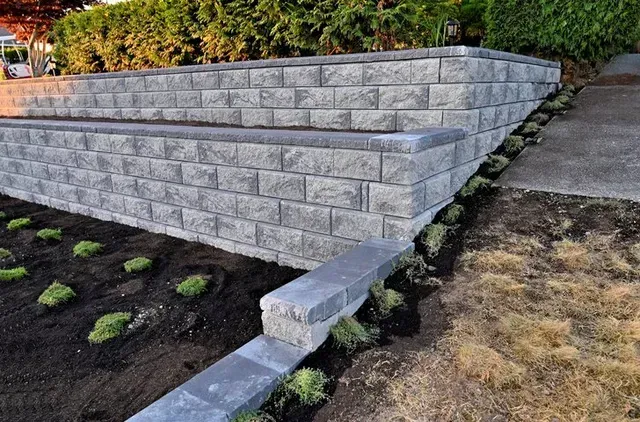Blog

Comprehensive Guide to the Types of Retaining Walls in Hardscaping
Types of Retaining Walls in Hardscaping
Retaining walls play a critical role in hardscaping, providing both functionality and aesthetic value. They help prevent soil erosion, manage water runoff, and create usable spaces on sloped terrain. By understanding the various types of retaining walls, you can choose the best fit for your landscaping needs.
Introduction
Retaining walls are an essential element in many landscaping and hardscaping projects. These structures are designed to hold back soil and stabilize uneven terrains, ensuring the safety and longevity of your property. Beyond their functional role, retaining walls also add depth and character to outdoor spaces, making them a favorite among homeowners and landscapers alike.
When it comes to hardscaping, retaining walls come in many forms, each offering unique advantages depending on the project’s requirements. From durable concrete walls to eco-friendly living walls, the choice of retaining wall type depends on factors like soil type, budget, and aesthetic preferences.
Gravity Retaining Walls
Definition and Structure
Gravity retaining walls rely on their weight to resist the pressure of the soil behind them. These walls are usually constructed from heavy materials, such as concrete, stone, or brick, and are designed with a thick base that tapers toward the top. Their straightforward design makes them one of the oldest and most commonly used types of retaining walls.
Types of Materials Used
Concrete Blocks: Known for their durability and clean look, concrete blocks are a popular choice for gravity walls.
Stone: Offers a natural and rustic appearance, making it ideal for traditional landscapes.
Brick: Provides a classic aesthetic but may require more maintenance over time.
Pros and Cons
Pros:
Easy to construct with readily available materials.
Highly durable and long-lasting.
Suitable for a wide range of soil conditions.
Cons:
May require significant space due to their wide base.
Not ideal for very tall walls.
Cantilever Retaining Walls
Design and Functionality
Cantilever retaining walls consist of a thin, vertical stem connected to a wide base slab. The weight of the soil on the base counteracts the pressure from the retained soil, making these walls highly efficient for taller structures. They often include reinforcement like steel bars to enhance stability.
Common Uses
Cantilever walls are commonly used in commercial and residential projects where space is limited. Their design allows them to support substantial loads without taking up too much ground area.
Benefits and Drawbacks
Benefits:
Require less material compared to gravity walls.
Suitable for tall walls and high-load applications.
Drawbacks:
Complex to design and build, requiring professional expertise.
Higher initial construction cost.
Sheet Pile Retaining Walls
Overview
Sheet pile retaining walls are thin walls made from materials like steel, vinyl, or wood. These walls are driven deep into the ground to resist soil pressure, making them ideal for soft soils or areas near water.
Materials and Applications
Steel: Offers excellent strength and durability, especially for heavy loads.
Vinyl: Resistant to corrosion, suitable for marine environments.
Wood: Cost-effective but less durable compared to steel or vinyl.
Advantages and Disadvantages
Advantages:
Ideal for tight spaces and constrained areas.
Quick installation process.
Disadvantages:
Limited height capabilities.
Prone to corrosion in certain environments (depending on material).
Anchored Retaining Walls
Structural Design
Anchored retaining walls utilize cables or rods anchored into the ground to provide additional support. This design makes them suitable for walls that need to bear heavy loads without compromising stability.
Best Situations for Use
These walls are often used in areas with steep slopes or loose soils. They are also a preferred choice when constructing tall retaining walls in limited spaces.
Pros and Cons
Pros:
Provides high stability, even in challenging conditions.
Suitable for tall or steep walls.
Cons:
More complex and expensive to construct.
Requires specialized equipment for anchoring.
Reinforced Retaining Walls
Explanation of Reinforcement Techniques
Reinforced retaining walls incorporate additional materials, such as steel bars or geogrids, to enhance their strength. This reinforcement allows them to withstand greater loads and resist soil pressure effectively.
Commonly Used Materials
Steel: Provides unmatched strength and longevity.
Geogrids: Lightweight and cost-effective, often used in combination with concrete or soil.
Benefits of Reinforcement
Reinforced walls offer superior stability and can be tailored to suit various conditions, making them an excellent choice for both residential and commercial projects.
Segmental Retaining Walls
Definition
Segmental retaining walls are constructed using interlocking blocks, typically made of concrete. These blocks are designed to fit together without the need for mortar, making them a versatile and efficient option for many landscaping projects. Their modular nature allows for flexibility in design, accommodating curves and angles with ease.
Installation Process
The installation begins with preparing the foundation, ensuring it is level and compacted. The blocks are then laid in a staggered pattern to enhance stability. Geogrid reinforcements may be added for taller walls to improve strength and prevent shifting over time.
Durability and Maintenance
Segmental retaining walls are highly durable, resistant to weather conditions, and require minimal maintenance. Regular inspections for block alignment and occasional cleaning are typically all that’s needed to keep them in excellent condition.
Gabion Retaining Walls
What Are Gabion Walls?
Gabion retaining walls are constructed by filling wire mesh cages with materials like stone, concrete, or other aggregates. These walls are often used in environmentally focused designs because they integrate natural elements with structural functionality.
Applications in Landscaping
Gabion walls are perfect for areas prone to erosion, such as riverbanks and coastal zones. They are also used in modern landscaping to create stylish, industrial aesthetics.
Environmental Benefits
Gabion walls promote drainage and reduce water pressure buildup, preventing soil erosion effectively. Additionally, they can incorporate vegetation into their structure, blending seamlessly with natural surroundings.
Crib Retaining Walls
Structure and Design
Crib retaining walls are built using a framework of interlocking materials, such as timber or precast concrete, creating a grid-like structure. These grids are then filled with soil or rocks, providing stability and support.
Types of Cribs
Timber Cribs: These offer a rustic look but may require treatment to resist decay.
Concrete Cribs: Durable and ideal for larger-scale projects, concrete cribs are highly resistant to environmental wear.
Advantages and Challenges
Advantages:
Flexible design options.
Excellent for retaining loose or granular soils.
Challenges:
Timber cribs may degrade over time.
Installation can be labor-intensive, especially for larger walls.
Natural Stone Retaining Walls
Aesthetic Appeal
Natural stone retaining walls are unmatched in their beauty and charm. They provide a timeless, elegant appearance that complements any landscaping style. Whether used in a modern garden or a rustic countryside setting, natural stone adds a sophisticated touch.
Construction Techniques
Building a natural stone wall requires careful stacking of stones to ensure stability. Dry-stacked walls rely on precise placement without mortar, while mortared walls use cement for added strength.
Pros and Cons
Pros:
Highly durable and weather-resistant.
Enhances the natural beauty of landscapes.
Cons:
Higher cost compared to other options.
Time-consuming construction process.
Timber Retaining Walls
Design and Durability
Timber retaining walls are constructed using treated wood to resist decay and insect damage. They are a cost-effective option for smaller projects and offer a warm, organic look that blends well with natural surroundings.
Common Applications
These walls are ideal for garden beds, low terraces, or as decorative elements in hardscaping designs. Their lightweight nature makes them easier to install compared to heavier materials like concrete or stone.
Maintenance Tips
Regular sealing and inspections are necessary to prevent rot and extend the lifespan of timber walls. Ensuring proper drainage behind the wall can also reduce moisture buildup and potential damage.
Living Retaining Walls
Integration with Vegetation
Living retaining walls incorporate plants and vegetation into their design, making them an eco-friendly choice. These walls typically use systems like geotextile fabric or modular planters to support plant growth while retaining soil.
Environmental Benefits
Living walls help reduce heat, improve air quality, and support biodiversity. They also provide natural insulation, which can be beneficial for nearby structures.
Challenges in Construction
Building a living wall requires careful planning to ensure proper drainage and plant selection. Regular maintenance is essential to keep the vegetation healthy and thriving.
Choosing the Right Retaining Wall
Selecting the best retaining wall for your project depends on various factors, including:
Budget: Some materials and designs are more cost-effective than others.
Soil Type: Loose or unstable soils may require more robust solutions.
Purpose: Whether you’re preventing erosion or creating a decorative element.
Consulting with a professional landscaper or engineer can help you make an informed decision tailored to your needs.
Conclusion
Retaining walls are a fundamental aspect of hardscaping, offering both functional and aesthetic benefits. With options ranging from durable concrete walls to eco-friendly living walls, there’s a solution for every landscape. By understanding the unique features of each type, you can choose a wall that complements your design and meets your project’s requirements.
FAQs
What is the strongest type of retaining wall?
Reinforced and anchored retaining walls are among the strongest, offering excellent stability for tall or high-load structures.How long do retaining walls typically last?
The lifespan varies by material, with concrete and stone walls lasting 50+ years, while timber walls may last 20–30 years with proper care.Can retaining walls be built on sloped terrain?
Yes, many retaining walls, such as cantilever or anchored walls, are designed specifically for sloped terrains.What permits are required for building a retaining wall?
Permit requirements depend on your local regulations and the wall’s height. Check with your local building authority.What are the common mistakes to avoid when building retaining walls?
Key mistakes include poor drainage, inadequate foundation, and failing to account for soil pressure.
Transform Your Yard with Expert Care
We take pride in delivering exceptional hardscaping
services for a healthy and vibrant yard.
Frequently Asked Questions
What is hardscaping and how does it differ from landscaping?
Hardscaping refers to the non-living elements of your outdoor space, including patios, walkways, retaining walls, and outdoor kitchens, made from hard materials like stone, brick, and concrete. Landscaping encompasses the living, horticultural elements such as plants, trees, and lawns.
How long does a typical hardscaping project take to complete?
The duration of a hardscaping project can vary significantly based on its scope, complexity, and the materials used. Smaller projects might take a few days, while larger, more intricate designs can take several weeks. We'll provide a more accurate timeline after discussing your specific needs and reviewing your project's details.
Do I need to obtain any permits for my hardscaping project?
Depending on the nature and location of your project, permits may be required. Our team will assess the need for permits during the initial consultation and handle the application process for you if necessary.
Can hardscaping improve my property value?
Yes, high-quality hardscaping can significantly enhance your property's curb appeal and increase its overall value. Well-designed outdoor spaces are highly sought after and can be a compelling feature if you decide to sell your home.
How should I maintain my new hardscape to ensure its longevity?
Maintenance requirements vary by material, but generally, we recommend regular cleaning and sealing of pavers and stone to protect against weathering and stains. We will provide you with specific care instructions tailored to your project's materials upon completion.
Can hardscaping solutions be eco-friendly?
Absolutely. We offer a variety of eco-friendly hardscaping options, including permeable pavers that allow for water infiltration and reduce runoff, and the use of recycled or locally sourced materials. Our team is committed to sustainable practices that benefit both our clients and the environment.
